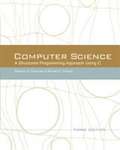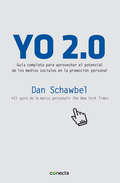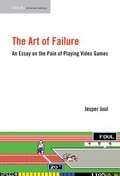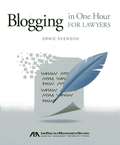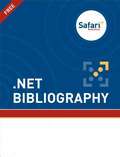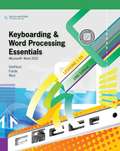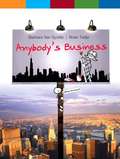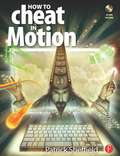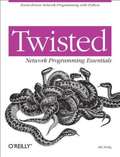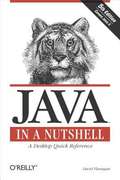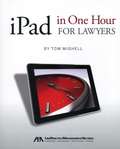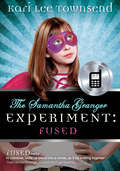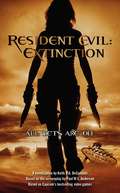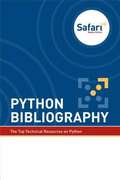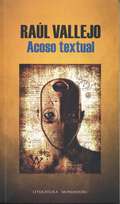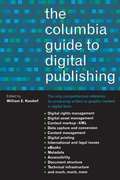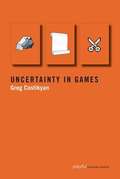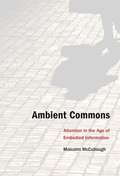- Table View
- List View
Computer Science: A Structured Programming Approach Using C (3rd edition)
by Behrouz A. Forouzan Richard F. GilbergThe third edition of Computer Science: A Structured Programming Approach Using C continues to present both computer science theory and C-language syntax with a principle-before-implementation approach. Forouzan and Gilberg employ a clear organizational structure, supplemented by easy-to-follow figures, charts, and tables. The new edition has been thoroughly updated to reflect the new C99 standard, and includes a revised chapter sequence to better aid student learning.
YO 2.0
by Dan SchawbelLos nuevos medios sociales abren un campo enorme de posibilidades en cualquier lugar del mundo. Para conseguir tus objetivos la estrategia más poderosa se basa en lograr diferenciarse mediante tu marca personal. Gracias a las herramientas de los nuevos medios, los blogs y las aplicaciones móviles, existen infinitas oportunidades para darte a conocer y conectar con otras personas.Tanto si estás buscando un trabajo, quieres dar un giro en tu carrera o aspiras a una promoción, Dan Schawbel , el gurú de la marca personal, te guía por el amplio territorio de los medios sociales y te muestra numerosos casos de éxito de personas que han construido sus marcas personales gracias a los medios sociales.Desde los sitios especializados en networking, como LinkedIn, Facebook o Twitter, hasta el potencial de los blogs, de los curriculums en video y de las aplicaciones móviles, Yo 2.0 representa una guía completa, práctica y actualizada para potenciar su marca personal y lograr sus objetivos profesionales.
The Art of Failure
by Jesper JuulWe may think of video games as being "fun," but in The Art of Failure, Jesper Juul claims that this is almost entirely mistaken. When we play video games, our facial expressions are rarely those of happiness or bliss. Instead, we frown, grimace, and shout in frustration as we lose, or die, or fail to advance to the next level. Humans may have a fundamental desire to succeed and feel competent, but game players choose to engage in an activity in which they are nearly certain to fail and feel incompetent. So why do we play video games even though they make us unhappy? Juul examines this paradox. In video games, as in tragic works of art, literature, theater, and cinema, it seems that we want to experience unpleasantness even if we also dislike it. Reader or audience reaction to tragedy is often explained as catharsis, as a purging of negative emotions. But, Juul points out, this doesn't seem to be the case for video game players. Games do not purge us of unpleasant emotions; they produce them in the first place. What, then, does failure in video game playing do? Juul argues that failure in a game is unique in that when you fail in a game, you (not a character) are in some way inadequate. Yet games also motivate us to play more, in order to escape that inadequacy, and the feeling of escaping failure (often by improving skills) is a central enjoyment of games. Games, writes Juul, are the art of failure: the singular art form that sets us up for failure and allows us to experience it and experiment with it. The Art of Failure is essential reading for anyone interested in video games, whether as entertainment, art, or education.
The 2013 Legal Technology Guide Solo and Small Firm
by Sharon D. Nelson John W. Simek Michael C. MaschkeThis annual guide is the only one of its kind written to help solo and small firm lawyers find the best technology for their dollar. You'll find the most current information and recommendations on computers, servers, networking equipment, legal software, printers, security products, smartphones, the iPad and anything else a law office might need. It's written in clear, easily understandable language to make implementation easier if you choose to do it yourself, or you can use it in conjunction with your IT consultant. Either way, you'll learn how to make technology work for you
Blogging in One Hour for Lawyers
by Ernie SevensonUntil a few years ago, only the largest firms could afford to engage an audience of millions. Now, lawyers in any size firm can reach a global audience at little to no cost—all because of blogs. An effective blog can help you promote your practice, become more "findable" online, and take charge of how you are perceived by clients, journalists and anyone who uses the Internet. Blogging in One Hour for Lawyers will show you how to create, maintain, and improve a legal blog—and gain new business opportunities along the way. In just one hour, you will learn to: • Set up a blog quickly and easily • Write blog posts that will attract clients • Choose from various hosting options like Blogger, TypePad, and WordPress • Make your blog friendly to search engines, increasing your ranking • Tweak the design of your blog by adding customized banners and colors • Easily send notice of your blog posts to Facebook and Twitter • Monitor your blog's traffic with Google Analytics and other tools • Avoid ethics problems that may result from having a legal blog
.NET Bibliography
by Safari Content TeamWhen Microsoft released the first beta of the .NET Framework in 2000 it quickly became the default way of developing software for Windows. Rising from the technological legacy of COM, with the C# language, Common Language Runtime (CLR), Intermediate Language (IL) and Just-in-time (JIT) compilation, it was a modern platform that made it easy for Java and C++ developers to develop for Windows. At the same time, Visual Basic .NET provided a natural transition path for Visual Basic developers. Since then, .NET has evolved and branched through 7 major releases of the framework to the current day, and with Windows 8, Microsoft has surprised developers with a completely new UI stack. In this highly competitive world of technology, Microsoft makes the operating system that is running on over a billion computers, yet they continue innovating with unique features of programming languages, and breakthroughs such as Kinect or PixelSense. .NET offers an environment that is a pleasure to develop on and a consistent platform where you will feel at home moving from one technology stack to another. Should you decide to explore the exciting world of .NET development, be sure to use this bibliography to access Safari Books Online resources that will help you understand and master .NET programming.
Keyboarding and Word Processing Essentials: Microsoft Word 2010 (18th Edition)
by Susie H. Vanhuss Connie M. Forde Donna L. WooThe Eighteenth Edition of KEYBOARDING AND WORD PROCESSING ESSENTIALS, LESSONS 1-55 uses proven techniques to help readers master the keyboarding and formatting skills they need for career success-from initial new-key learning to expertise in formatting business documents with Microsoft Word 2010. South-Western College Keyboarding offers a proven, time-tested approach that helps readers develop a strong foundation in basic keyboarding, steadily improve their skills, and rapidly become proficient in document formatting and business communication. Each lesson is clearly focused, well structured, and designed to provide step-by-step training and reinforcement to help readers quickly acquire and apply new skills. This one-book solution includes 55 lessons, documents, and software instructions within a space-saving easel-back format.
Anybody's Business
by Barbara Van Syckle Brian TietjeMore than a book, Anybody's Business is an approach to business and life that harnesses the best of people and how they work together to produce a transformation in perspective and purpose. This text shows the students the connections between business concepts and their everyday lives. The skills they learn can be put to use from the moment they leave the classroom and throughout their professional journey.
How to Cheat in Motion
by Patrick SheffieldThe text provides a "cookbook" style of learning computer animation, presenting the user with specific recipes to achieve desirable outcomes. This practical guide helps readers to enhance titles, motion graphics and visual effects with Motion. Step-by-step instruction is concisely described and lavishly illustrated.
Copyright Exceptions: The Digital Impact
by Robert Burrell Allison ColemanThis book was first published in 2005. Copyright 'exceptions' or 'users' rights' have become a highly controversial aspect of copyright law. Most recently, Member States of the European Union have been forced to amend their systems of exceptions so as to comply with the Information Society Directive. Taking the newly amended UK legislation as a case study, this book examines why copyright exceptions are necessary and the forces that have shaped the present legislative regime in the UK. It seeks to further our understanding of the exceptions by combining detailed doctrinal analysis with insights gained from a range of other sources. The principal argument of the book is that the UK's current system of 'permitted acts' is much too restrictive and hence is in urgent need of reform, but that paradoxically the Information Society Directive points the way towards a much more satisfactory approach.
Twisted Network Programming Essentials
by Abe Fettig<p><i>Twisted Network Programming Essentials</i> from O'Reilly is a task-oriented look at Twisted, a Python-based network application framework. Twisted is fast becoming indispensable to Python network programmers. It supports common networking protocols such as TCP/IP, SSH, and SMTP. Using Python and Twisted, you can develop web services applications, email clients and servers, and just about any other type of networking application that you can conceive.</p>
Java in a Nutshell, 5th Edition
by David FlanaganThe 1.4 release of Java 2 Standard edition brings a load of new features - and the potential for frustration. Fret not, our new 4th edition has answers. The accelerated introduction lets you start writing code right away, and because the book's classic quick reference contains all the classes in the essential Java packages, you can find exactly what you need to make Java's new version work for you.
Verification and Validation in Scientific Computing
by William L. Oberkampf Christopher J. RoyAdvances in scientific computing have made modelling and simulation an important part of the decision-making process in engineering, science, and public policy. This book provides a comprehensive and systematic development of the basic concepts, principles, and procedures for verification and validation of models and simulations. The emphasis is placed on models that are described by partial differential and integral equations and the simulations that result from their numerical solution. The methods described can be applied to a wide range of technical fields, from the physical sciences, engineering and technology and industry, through to environmental regulations and safety, product and plant safety, financial investing, and governmental regulations. This book will be genuinely welcomed by researchers, practitioners, and decision makers in a broad range of fields, who seek to improve the credibility and reliability of simulation results. It will also be appropriate either for university courses or for independent study.
Artificial Intelligence
by David L. Poole Alan K. MackworthConstraint-based reasoning is an important area of automated reasoning in artificial intelligence, with many applications. These include configuration and design problems, planning and scheduling, temporal and spatial reasoning, defeasible and causal reasoning, machine vision and language understanding, qualitative and diagnostic reasoning, and expert systems. Constraint-Based Reasoning presents current work in the field at several levels: theory, algorithms, languages, applications, and hardware. Constraint-based reasoning has connections to a wide variety of fields, including formal logic, graph theory, relational databases, combinatorial algorithms, operations research, neural networks, truth maintenance, and logic programming. The ideal of describing a problem domain in natural, declarative terms and then letting general deductive mechanisms synthesize individual solutions has to some extent been realized, and even embodied, in programming languages. Contents :- Introduction, E. C. Freuder, A. K. Mackworth. - The Logic of Constraint Satisfaction, A. K. Mackworth. - Partial Constraint Satisfaction, E. C. Freuder, R. J. Wallace. - Constraint Reasoning Based on Interval Arithmetic: The Tolerance Propagation Approach, E. Hyvonen. - Constraint Satisfaction Using Constraint Logic Programming, P. Van Hentenryck, H. Simonis, M. Dincbas. - Minimizing Conflicts: A Heuristic Repair Method for Constraint Satisfaction and Scheduling Problems, S. Minton, M. D. Johnston, A. B. Philips, and P. Laird. - Arc Consistency: Parallelism and Domain Dependence, P. R. Cooper, M. J. Swain. - Structure Identification in Relational Data, R. Dechter, J. Pearl. - Learning to Improve Constraint-Based Scheduling, M. Zweben, E. Davis, B. Daun, E. Drascher, M. Deale, M. Eskey. - Reasoning about Qualitative Temporal Information, P. van Beek. - A Geometric Constraint Engine, G. A. Kramer. - A Theory of Conflict Resolution in Planning, Q. Yang. A Bradford Book.
The Text Mining Handbook
by Ronen Feldman James SangerText mining tries to solve the crisis of information overload by combining techniques from data mining, machine learning, natural language processing, information retrieval, and knowledge management. In addition to providing an in-depth examination of core text mining and link detection algorithms and operations, this book examines advanced pre-processing techniques, knowledge representation considerations, and visualization approaches. Finally, it explores current real-world, mission-critical applications of text mining and link detection in such varied fields as M&A business intelligence, genomics research and counter-terrorism activities.
Programming in Visual Basic 2010
by Jim MckeownThis is an introduction to programming using Microsoft's Visual Basic. NET 2010, intended for novice programmers with little or no programming experience or no experience with Visual Basic. The text emphasizes programming logic and good programming techniques with generous explanations of programming concepts written from a non-technical point of view. It stresses input, processing, and output and sequence, selection, and repetition in code development. File I/O and arrays are included. Later chapters introduce objects, event programming, and databases. By taking a slow and steady approach to programming ideas, this book builds new concepts from what the reader has already learned. VB tips and quips inject both humor and insight. The book includes numerous programming examples and exercises, case studies, tutorials, and "fixing a program" sections for an in-depth look at programming problems and tools. Quizzes and review questions throughout each chapter get students to think about the materials and how to use them. Each chapter has a summary and glossary for extra review. The accompanying Web site, www.cambridge.org/us/McKeown, has code downloads, I/O, and database files from small, simple files to large files with thousands of records, flowcharts, deskchecks and audits to aid with program design, coding, and debugging; PowerPoint files for every chapter; and hundreds of ideas for programs and projects.<P> Advisory: Bookshare has learned that this book offers only partial accessibility. We have kept it in the collection because it is useful for some of our members. To explore further access options with us, please contact us through the Book Quality link on the right sidebar. Benetech is actively working on projects to improve accessibility issues such as these.
iPad in One Hour for Litigators
by Tom MighellWhether you are a new or a more advanced iPad user, iPad in One Hour for Lawyers takes a great deal of the mystery and confusion out of using your iPad. Ideal for lawyers who want to get up to speed swiftly, this book presents the essentials so you don't get bogged down in technical jargon and extraneous features and apps.
The Samantha Granger Experiment: Fused
by Kari Lee Townsend<p>When you make a face or cross your eyes, do your parents tease that if you're not careful, your face might stay that way forever?<br>Well, my parents said that if I'm not careful, I'll turn into one of my gadgets. </p><p><b>I thought they were joking, people!</b></p><p>But-somehow, someway-I have become a living, breathing, walking piece of technology. Apparently my head now has a built-in GPS and my palm is equipped with talking and texting capabilities-just like my cell phone!</p><p>Now I'm a techno-superhero with powers that seem to have a mind of their own. And, in my case, keeping a secret identity is harder than it sounds. I short-circuit every time Trevor Hamilton looks my way. </p><p>Like being a girl isn't stressful enough. </p>
Resident Evil: Extinction
by Keith R. A. DecandidoFollowing the events of Resident Evil: Apocalypse, the beautiful, dangerous, enigmatic Alice returns, and this time she and her fellow survivor Carlos Olivera are running with a pack of humans led by a new ally, Claire Redfield. Together they are cutting through the wastelands of the United States on a long trek to Alaska. Hunted by the minions of the scheming Dr. Isaacs, Alice has zombies hungry for her flesh and the Umbrella Corporation's monstrous lab rats hungry for her blood...while Alice herself hungers only for revenge.
Python Bibliography
by Developers From DevzoneTwenty years ago, Guido van Rossum was hard at work on the first release of Python. A lot has changed in those twenty years. Many of the programming languages that were contemporaries of Python have started showing their age. Meanwhile, there have been no shortages of new programming languages, yet Python continues to hold up well. Its emphasis on clean syntax, and its melding of object-oriented and functional programming elements, put it years ahead of the other popular languages from the 1990s. The story of Python is not only about it being ahead of its time in terms of syntax and features. It is also about its open development and the community around it. Its value as a scripting language is well known, and it ships with many operating systems. For years Python has been one of the Pâ TMs in the LAMP stack used for numerous web applications. Indeed, Pythonâ TMs popularity with web developers has lead to a multitude of web application frameworks written in Python: Django, TurboGears, Pylons, CherryPy, and so on. Even with technology's fast-moving pace, Python remains on the cutting edge. NoSQL data stores have become increasingly popular, and you can find first class support for using Python with any of these technologies. This is just further evidence of the continued popularity of Python and the vibrant community around it. This bibliography contains a wide selection of books about Python. These range from various introductory to advanced books. Of course, web development is covered, but you might be surprised to see the wide variety of other types of development that are done using Python. Whether you are working on machine learning or just hacking in your spare time, Python has something for you.
Our Digital World: Introduction to Computing
by Jon Gordon Denise Seguin Nancy Muir Karen Lankisch Anita VernoThe authors of Our Digital World have done a lot of work to make the writing in this book easy to read, to find ways to get you excited about how technology is evolving, and to make computing relevant to your work and personal lives.
Acoso Textual
by Raúl Vallejo¿Una? ¿Un? estudiante universitario explora su identidad inventando múltiples personalidades virtuales e intercambiando correos electrónicos con curiosos personajes, virtuales ellos también, alrededor del mundo. Así, banano@wam.umd.edu en ocasiones se presenta como un romántico en busca del amor, en otras es una posgraduada de ciencias políticas que problematiza las utopías socialistas del siglo xx, o se convierte en un explorador del placer del sexo virtual. Para cada uno de sus interlocutores cibernéticos tiene un género, un interés y una personalidad distintos. Es un ser andrógino como el lenguaje. Ahora, banano@wam.umd.edu debe enfrentarse a sus propias preguntas: ¿Debo matar a las personalidades ficticias para encontrar mi identidad verdadera? ¿Debería convertir mis relaciones virtuales en realidades físicas? ¿Qué valor tiene la palabra virtual? Acoso textual, novela pionera en la literatura hispanoamericana en el uso de correos electrónicos para relaciones epistolares, nos ubica en un espacio virtual en que las personas se construyen a sí mismas con las palabras que van y vienen a través de Internet.
The Columbia Guide to Digital Publishing
by William E. KasdorfWhat is metadata? When do you need to archive digital content? How does electronic publication affect copyrights? How can XML and PDF improve your workflow and your publications? There is a digital dimension to virtually all publishing today. Beyond the obvious electronic media -- the music and movies we take for granted, the increasingly indispensable Web, the eBooks that most of us will take for granted in a few years -- almost everything we read, even on paper, was produced digitally. This new digital world offers a steadily increasing number of choices. It is this rich and rapidly changing publishing environment for which The Columbia Guide to Digital Publishingwas created. Although there is a vast amount of information on a host of topics relevant to digital production and publishing available -- some in print, more on the Web -- there has been, until now, no single resource to which those involved in any dimension of publishing could turn for guidance. The Columbia Guide to Digital Publishing fills that need. The Guide is definitive: written by experts in the broad array of subjects it covers, it provides reliable, authoritative, user-friendly information about a vast number of topics. Designed to be the first place to go to learn about any of the numerous interrelated issues that define the digital publishing landscape, it offers readers a multilevel approach, from a brief glossary definition of a technical term or acronym (sometimes all a user needs), to a concise discussion of a topic (comprehensible to the lay person, yet useful for the technical expert). It puts a subject in the context of other topics and broader issues, with real-world examples, liberal cross-references, and pointers to sources of further information in print or electronic form.
Uncertainty in Games
by Greg CostikyanIn life, uncertainty surrounds us. Things that we thought were good for us turn outto be bad for us (and vice versa); people we thought we knew well behave in mysterious ways; thestock market takes a nosedive. Thanks to an inexplicable optimism, most of the time we are fairlycheerful about it all. But we do devote much effort to managing and ameliorating uncertainty. Is itany wonder, then, asks Greg Costikyan, that we have taken this aspect of our lives and transformedit culturally, making a series of elaborate constructs that subject us to uncertainty but in afictive and nonthreatening way? That is: we create games. In this concise and entertaining book,Costikyan, an award-winning game designer, argues that games require uncertainty to hold ourinterest, and that the struggle to master uncertainty is central to their appeal. Game designers, hesuggests, can harness the idea of uncertainty to guide their work. Costikyan explores the manysources of uncertainty in many sorts of games -- from Super Mario Bros. toRock/Paper/Scissors, from Monopoly toCityVille, from FPS Deathmatch play to Chess. He describestypes of uncertainty, including performative uncertainty, analytic complexity, and narrativeanticipation. And he suggest ways that game designers who want to craft novel game experiences canuse an understanding of game uncertainty in its many forms to improve their designs.
Ambient Commons
by Malcolm McculloughThe world is filling with ever more kinds of media, in ever more contexts andformats. Glowing rectangles have become part of the scene; screens, large and small, appeareverywhere. Physical locations are increasingly tagged and digitally augmented. Sensors, processors,and memory are not found only in chic smart phones but also built into everyday objects. Amid thisflood, your attention practices matter more than ever. You might not be able to tune this world out. So it is worth remembering that underneath all these augmentations and data flows, fixed formspersist, and that to notice them can improve other sensibilities. In AmbientCommons, Malcolm McCullough explores the workings of attention though a rediscovery ofsurroundings. Not all that informs has been written and sent; not all attention involves deliberatethought. The intrinsic structure of space -- the layout of a studio, for example, or a plaza --becomes part of any mental engagement with it. McCullough describes what he calls the Ambient: anincreasing tendency to perceive information superabundance whole, where individual signals matterless and at least some mediation assumes inhabitable form. He explores how the fixed forms ofarchitecture and the city play a cognitive role in the flow of ambient information. As apersistently inhabited world, can the Ambient be understood as a shared cultural resource, to besocially curated, voluntarily limited, and self-governed as if a commons? AmbientCommons invites you to look past current obsessions with smart phones to rethink attentionitself, to care for more situated, often inescapable forms of information.
